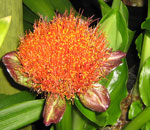Scadoxus puniceus
Snake
Lily;
idumbe-lika-nhloyile Article by Geoff Nichols
By the time
many of you on the coast read this article this plant will have
finished
its spring show. But do not despair the seeds that develop in the
flowering
head will give you another show of red berries in October and November.
The Snake Lily is a member of the amaryllis family of bulbs with a
spotted base to the leaves giving the plant its reptilian look. Another
theory is the new flower shoots that appear in spring are arrow or
snake head-shaped with a serpentine bend in the young flowering stem.
I remember an old Zulu man telling me that when these plants began to
flower in spring it was a sign for him and other members of his clan to
begin preparing the fields for planting the new crop of maize. It is
wonderful to be able to track your seasons of life in the cycles of
plants.
|

Click on
Image
|
In forests
and bushclumps where this species occurs you often find the plants
growing
in amongst rocks and other sheltered spots like the base of a tree.
Protection
from fire and animals browsing the shoots is an important factor for
any
plant. Another reason for these bulbs being partially lithophytic or
growing
on rocks is because moles love the bulbs and will work through a colony
of
bulbs eating up through the base plate into the bulb.
I have even had a mole burrow up into an old style clay pot that had a
big
drainage hole and eat my prize specimens. Ensure you have plenty of
drainage
“crocks” or stones in the bottom of the pot to thwart these little
animals.
This species makes a very exciting container plant with the bulbs
slightly
above the soil surface making a very attractive sculpture even when the
bulbs
are dormant in winter.
From seed these bulbs will be mature enough to flower in about their
fourth
growing season. Harvest seeds when they are red and ripe. Clean off the
flesh
and you have a pearl–like rounded seed that you sow onto a well drained
and
loose compost and sand mixture. The seeds will germinate in about two
to
three weeks and they send down a root and the tiny spotted bulb forms
with
virtually no leaf in the first year and will only produce a proper leaf
in
the second year.
Only move these bulbs in the winter when they are dormant grow the
plants
in a medium that loose and rich in organic matter. Fertilize or add
broken
down leaf litter on the roots in early spring for best results.
At Zimbali the loose dune sands are very rich in leaf litter and the
plants
do very well if they are watered well during the summer. Under
extensive
or wild conditions these plants seem not to attract the Amaryllis
caterpillar.
But in your gardens if you have too many plants close together the moth
will
find the concentration of plants and lay its eggs under the leaves and
before
you know it the caterpillars have eaten your prize plant.
